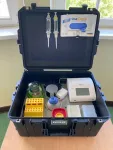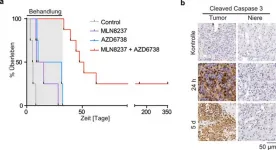(Press-News.org) Observations of lithium and potassium around white dwarf stars point to remains of rocky planet crusts
Analysis by astronomers led by University of Warwick shows chemical composition of crusts is very similar to Earth's continental crust
The outer layers of the white dwarfs contain up to 300,000 gigatonnes of rocky debris, which includes up to 60 gigatonnes of lithium and 3,000 gigatonnes of potassium
These white dwarfs are among the oldest stars in our galaxy, and could host one of the oldest planetary systems discovered so far
Remnants of planets with Earth-like crusts have been discovered in the atmospheres of four nearby white dwarf stars by University of Warwick astronomers, offering a glimpse of the planets that may have once orbited them up to billions of years ago.
These crusts are from the outer layers of rocky planets similar to Earth and Mars and could give astronomers greater insights into the chemistry of the planets that these dying stars once hosted.
The discovery is reported today (11 February) in the journal Nature Astronomy and includes one of the oldest planetary systems seen by astronomers so far.
The University of Warwick-led team were analysing data from the European Space Agency's Gaia telescope of over 1,000 nearby white dwarf stars when they came across an unusual signal from one particular white dwarf. The researchers at the University of Warwick received funding from the European Research Council and the Science and Technology Facilities Council (STFC).
They used spectroscopy to analyse the light from the star at different wavelengths, which allows them to detect when elements in the star's atmosphere are absorbing light at different colours and determine what elements those are and how much is present. They also inspected the 30,000 white dwarf spectra from the Sloan Digital Sky Survey published over the last 20 years.
The signal matched the wavelength of lithium and the astronomers soon discovered three more white dwarfs with the same signal, one of which was also observed with potassium in its atmosphere. By comparing the amount of lithium and potassium with the other elements they detected - sodium and calcium - they found that the ratio of elements matched the chemical composition of the crust of rocky planets like Earth and Mars, if those crusts and been vaporised and mixed within the gaseous outer layers of the star for 2 million years.
Lead author Dr Mark Hollands from the University of Warwick's Department of Physics said: "In the past, we've seen all sorts of things like mantle and core material, but we've not had a definitive detection of planetary crust. Lithium and potassium are good indicators of crust material, they are not present in high concentrations in the mantle or core.
"Now we know what chemical signature to look for to detect these elements, we have the opportunity to look at a huge number of white dwarfs and find more of these. Then we can look at the distribution of that signature and see how often we detect these planetary crusts and how that compares to our predictions."
The outer layers of the white dwarfs contain up to 300,000 gigatonnes of rocky debris, which includes up to 60 gigatonnes of lithium and 3,000 gigatonnes of potassium, equivalent to a 60km sphere of similar density to Earth's crust. The amount of crust material detected is similar in mass to that of the asteroids we see in our own solar system, leading the astronomers to believe that what they are seeing around all four stars is material broken off from a planet, rather than an entire planet itself.
Previous observations of white dwarfs have found evidence of material from the inner core and mantle of planets, but no definitive evidence of crust material. Crust is a small fraction of a planet's mass and the elements detected in this study are only detectable when the star is very cool. White dwarfs are in the dying phase of their lifecycle, as they have burnt out their fuel and cool over billions of years. These four white dwarfs are thought to have burnt out their fuel up to 10 billion years ago and could be among the oldest white dwarfs formed in our galaxy.
Co-author Dr Pier-Emmanuel Tremblay from the University of Warwick said: "In one case, we are looking at planet formation around a star that was formed in the Galactic halo, 11-12.5 billion years ago, hence it must be one of the oldest planetary systems known so far. Another of these systems formed around a short-lived star that was initially more than four times the mass of the Sun, a record-breaking discovery delivering important constraints on how fast planets can form around their host stars."
Among the oldest of these white dwarfs, one is 70% more massive than average and so its huge mass would normally cause any material in its atmosphere to disappear relatively quickly, leading the astronomers to the conclusion that it must be replenishing the crust material from a surrounding debris disc. Furthermore, the astronomers detected more infrared light than expected for the white dwarf alone, which indicates a disc being heated by its star and then re-radiated at longer wavelengths.
Dr Hollands adds: "As we understand it, rocky planet formation happens in a similar way in different planetary systems. Initially, they are formed from similar material composition to the star, but over time those materials separate and you end up with different chemical compositions in different parts of the planets. We can see that at some point that these objects have undergone differentiation, where the composition is different to the starting composition of the star.
"It is now well understood that most normal stars like the Sun harbour planets, but now there's the opportunity to look at the frequency of different types of material as well."
INFORMATION:
* 'Alkali metals in white dwarf atmospheres as tracers of ancient planetary crusts' will be published in Nature Astronomy, DOI: 10.1038/s41550-020-01296-7
Link: https://www.nature.com/articles/s41550-020-01296-7
* This project has received funding from the European Research Council (ERC) under the European Union's Horizon 2020 research and innovation programme (Grant agreement No. 677706 (WD3D))
Notes to editors:
Artist's impression of planetary crusts accreting into a white dwarf available to download at the link below. This image is free for use if used in direct connection with this story but image copyright and credit must be University of Warwick/Mark Garlick:
https://warwick.ac.uk/services/communications/medialibrary/images/february_2021/accreting_wd2.jpg
Caption: Remnants of planetary crust disintegrating under the tidal forces around a cool white dwarf. Material in the disc becomes vaporised close to the central star and flows onto the white dwarf atmosphere. Credit: University of Warwick/Mark Garlick
For interviews or a copy of the paper contact:
Peter Thorley
Media Relations Manager (Warwick Medical School and Department of Physics) | Press & Media Relations | University of Warwick
Email: peter.thorley@warwick.ac.uk
Mob: +44 (0) 7824 540863
The Science and Technology Facilities Council (STFC)
The Science and Technology Facilities Council (STFC) is part of UK Research and Innovation - the UK body which works in partnership with universities, research organisations, businesses, charities, and government to create the best possible environment for research and innovation to flourish. For more information visit UK Research and Innovation.
STFC funds and supports research in particle and nuclear physics, astronomy, gravitational research and astrophysics, and space science and also operates a network of five national laboratories, including the Rutherford Appleton Laboratory and the Daresbury Laboratory, as well as supporting UK research at a number of international research facilities including CERN, FERMILAB, the ESO telescopes in Chile and many more.
Visit https://stfc.ukri.org/ for more information. @STFC_Matters
BOSTON -- Sleep and health are inextricably connected. New research from investigators at Brigham and Women's Hospital explores the connection between sleep disturbances and deficiencies among older adults and risk of dementia and death, finding that risk of dementia was double among participants who reported getting less than five hours of sleep compared to those who reported 7-8 hours of sleep per night. The team also found associations between sleep disturbance and sleep deficiency with overall risk of death. Results are published in Aging.
"Our findings illuminate a connection between sleep deficiency and risk of dementia and confirm the importance of efforts to help older individuals obtain ...
Combination of pine scent and ozone as super source of particulate emissions from coniferous forests
Scientists have managed to figure out why conifer forests produce so many fine particles into the atmosphere. Aerosol particles are particularly abundant when ?-pinene, the molecule responsible for the characteristic pattern of pine trees reacts with atmospheric ozone.
Atmospheric aerosol particles affect the Earth's climate by forming clouds, but at the same time they also pollute the air, thereby increasing mortality.
Aerosol particles in the atmosphere have their origins in many sources. The significant amount of aerosol particles in the atmosphere is caused ...
Multiple sclerosis (MS) is the most common neurological disease in young adults, affecting more than 2 million individuals worldwide, with about 1500 cases in Estonia. About 20% of MS patients experience optic neuritis (ON) as the presenting symptom, but not all ON patients develop MS.
The TalTech gene technology research unit, in collaboration with the laboratory of Protobios OÜ and medical researchers of the University of Helsinki, published their findings in the prestigious journal of EBioMedicine entitled "Identification of two highly antigenic epitope markers predicting multiple sclerosis in optic neuritis patients". The lead author Helle Sadam and co-authors Mariliis Jaago and Annika ...
Ithaca, NY--The European House Sparrow has a story to tell about survival in the modern world. In parts of its native range in Europe, House Sparrow numbers are down by nearly 60%. Their fate in the U.S. and Canada is less well known. A new study by Cornell Lab of Ornithology scientists aims to clarify the status of this non-native species, using 21 years of citizen science data from the Cornell Lab's Project FeederWatch. The results are published in the Wilson Journal of Ornithology.
"We wanted to find out where and how much House Sparrows might be declining here," explains lead author Liam Berigan, who did this work while at the Cornell Lab and who is now a Ph.D. student at the University of Maine. "We also explored whether the declines would match up with an increase in hawk ...
The CIPD is today launching a new research report, co-authored by the University of Bath's Dr Luke Fletcher, to highlight how LGBT+ workers tend to have a more negative experience of work.
'Inclusion at work: Perspectives on LGBT+ working lives' draws on data from the CIPD's UK Working Lives Survey and a separate survey of trans workers to explore their perspectives on working life, hence the intentional use of LGB+ rather than LGBT, in the research findings:
Over 40% of LGB+ workers experienced a conflict at work over a twelve-month period, compared with 29% of heterosexual workers. Conflicts typically involve being undermined/ humiliated or discriminatory behaviour aimed at a protected characteristic.
More than half (55%) of trans workers surveyed said they had experienced conflict ...
A commercially available genomic test may help oncologists better determine which patients with recurrent prostate cancer may benefit from hormone therapy, according to new research from the Johns Hopkins Kimmel Cancer Center and 15 other medical centers.
Researchers studied prostate cancer samples from 352 participants in the NRG/RTOG 9601 clinical trial, which compared radiation therapy alone with radiation therapy combined with hormone therapy. The investigators found that the Decipher test, which measures the activity of 22 genes among seven known cancer pathways, independently estimated the participants' risk of metastasis, death from prostate cancer and overall ...
The PCR test is the most accurate tool to identify SARS-CoV-2. However, valid results are often available only after days. Moreover, the laboratory must be well equipped, have trained personnel and sufficient financial resources. All of this is usually a problem in Africa. A portable suitcase could help. In cooperation with several African universities, scientists at Leipzig University have found that this mini-laboratory provides test results that are almost as good as a PCR test - and almost in real time. The researchers have now published their findings in the journal "Analytical Chemistry".
The compact case could provide rapid coronavirus test results in regions of ...
Neuroblastomas are malignant solid tumours that occur mainly in early childhood. They arise from degenerated immature cells of the sympathetic nervous system.
One prognostic marker to assess the malignancy of the tumour is the MYCN oncogene. High-risk neuroblastoma patients often have amplification of MYCN, i.e. very high levels of this protein, which drives uncontrolled tumour growth. Conversely, inhibiting MYCN or its function could be a promising therapeutic opportunity.
An important step towards this direction was taken by an international research project led by scientists ...
A urine test based on University of Michigan Rogel Cancer Center research could have avoided one third of unnecessary prostate cancer biopsies while failing to detect only a small number of cancers, according to a validation study that included more than 1,500 patients. The findings appear in the March issue of the Journal of Urology.
The MyProstateScore test, which is being commercialized by LynxDX, a U-M startup company, measures levels of cancer-specific genes in a patient's urine. It is based on U-M research that discovered that half of all prostate tumors harbor a certain ...
Among firearm-owning individuals who died by suicide, handgun ownership was associated with greater odds of having died by self-inflicted gunshot wound rather than by another method, according to a Rutgers researcher.
The study, published in the Archives of Suicide Research, surveyed surviving loved ones of 121 handgun and shotgun owners who died by suicide -- 93 of whom died with a firearm and 28 who died through other means -- and asked about the numbers and types of firearms the individuals had and the circumstances of their deaths.
The researchers found that 77 percent of those who died using a firearm, as well as 61 percent of those who died using another method, owned a handgun. They also found that 88.8 percent of individuals who only owned handguns used a firearm in their ...





